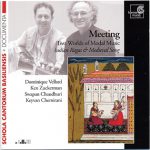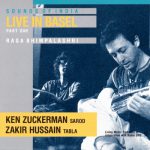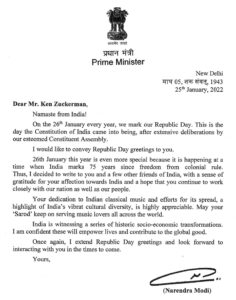Nature of Ragas – Ragas of Nature
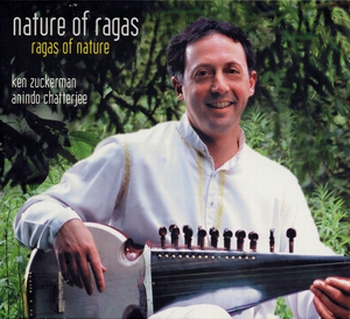
A collection of short vignettes, ideal as an introduction to Indian music.
To listen to a sample from Track 16, please click here:
To purchase this CD please follow one of the links below:
Review
Excellent sarod performances, connecting Indian classical music to the natural world.
The connection of Indian ragas to specific seasons and times of the day has long fascinated Western listeners. It’s an intriguing extra-musical dimension that immediately conjures up the scents and moods of another culture. However, it is unclear how literal these connections are and not all Indian musicians will make a simple link for example, between the ambience of early morning and a raga specified for performance at this time. Indian music is not programmatic in that straightforward sense – often the connections are more abstract and subtle
On his new CD, though, American sarod player Ken Zuckerman makes quite specific links between particular ragas and elements of nature, hence track titles such as ‘Morning Mist’, ‘Awakening’, ‘The Sun’s Welcome’, ‘Passing of the Day’, ‘Twilight’s Secret’ and ‘Soothing Rain’. In his view ‘the classical ragas have an almost magical power to bring us in closer contact with the natural world’.
Zuckerman is the accomplished student of sarod maestro Ali Akbar Khan and the latter’s influence permeates the album both in sound and aesthetic outlook (and because several of Khan’s original compositions are included). Zuckerman’s playing is impressive throughout, particularly in the alaps or unmetered introductions to the ragas where the delicate mood of each piece is explored in detail. He is accompanied by Anindo Chatterjee, one of India’s most renowned tabla players.
The liner notes, by Zuckerman, are detailed and informative, revealing to the listener the fascinating meanings of this music. Gerry Farrell
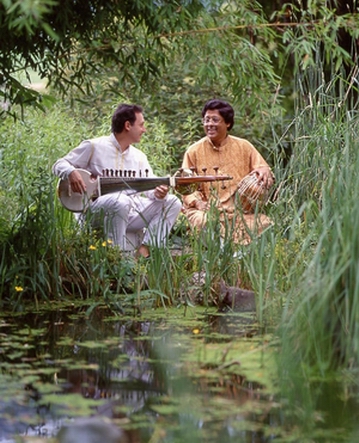
NATURE OF RAGAS – RAGAS OF NATURE
– A collection for times, moods and seasons
Ken Zuckerman, the internationally acclaimed disciple of legendary sarod maestro Ustad Ali Akbar Khan, presents a unique recording exploring the rich relationship between Indian ragas and the world of nature.
From melodies of the pre-dawn and late night to ragas of the rainy season and full moon, this collection of short vignettes is an ideal introduction to the classical music of North India.
The eight performances, ranging from four to seventeen minutes in length (total time 76:45), include traditional ragas Ahir Bhairav, Nat Bhairav, Bhimpalashri, Puriya Dhanashri, Desh Malhar and Sindhi Bhairavi, as well as Jogiya Kalingra and Chandranandan, two ragas composed by Ustad Ali Akbar Khan. Notes on each raga help give listeners an orientation to the natural imagery and moods of the music.
Anindo Chatterjee, one of India’s most renowned tabla masters, joins Ken on their debut recording together, providing his virtuosic accompaniment in a variety of traditional rhythmic cycles.
Track List – Total Time 76:45
MORNING MIST – Raga Jogiya Kalingra. A raga composed by Ustad Ali Akbar Khan, this melody captures the mystery and wonder of the pre-dawn hour.
1. Introduction (alap) 2:53
2. Theme and improvisations in sitarkhani tal(16). 7:48
AWAKENING – Raga Ahir Bhairav. This early morning raga, ideally performed at “the first light of the sun,” encompasses the diverse moods of peace, joy and pathos. Songs in Ahir Bhairav sometimes use texts that gently remind the young Lord Krishna that it is time to awaken.
3. Introduction 1:36
4. Theme and improvisations in slow jhaptal (10) 3:37
5. Theme and improvisations in medium jhaptal (10) 2:18
THE SUN’S WELCOME – Raga Nat Bhairav. A late morning raga, this melody is filled with heroic exuberance, along with a slight feeling of pathos. The excerpt was taken from a concert, which also accounts for the contrasting “live” acoustic sound texture.
6. Theme and improvisations in fast tintal (16) 3:26
PASSING OF THE DAY – Raga Bhimpalashri. This late afternoon raga, performed “when the sky begins to be red in the afternoon,” embodies the elegance, beauty and pathos of a day slowly coming to an end. Ustad Ali Akbar Khan has described Bhimpalashri as evoking the feeling of sadness that the animals in the forest have as they sense that the day will soon be over.
7. Introduction 3:52
8. Theme and improvisations in sitarkhani (16) 3:37
9. Theme and improvisations in fast tintal (16) 4:01
TWILIGHT’S SECRET – Raga Puriya Dhanashri. The power and mystery of the early evening is captured by this heroic and meditative traditional raga. Its half-step and augmented intervals contain a power and tension that search for resolution, embodying this mood of the evening in transition.
10. Introduction 4:37
SOOTHING RAIN – Raga Desh Malhar. This member of the Malhar family of ragas belonging to the monsoon season in India, has a sweetness and joy which seems to welcome the soothing rain after the heat of summer.
11. Introduction 5:24
12. Theme and improvisations in sitarkhani (16) 3:59
13. Theme and improvisations in fast tintal (16) 3:33
MOONSTRUCK – Raga Chandranandan. Considered by many to be Ustad Ali Akbar Khan’s greatest masterpiece, this late night melody is a unique fusion of four traditional ragas and celebrates the romance and attraction of the full moon.
14. Introduction 2:00
15. Theme and improvisations in slow tintal (16) 2:46
16. Theme and improvisations in fast tintal 3:29
PATH TO THE HEART – Raga Sindhi Bhairavi. This melody is a favorite of music lovers the world over. Its mixture of joy, pathos, peace and romance is the very essence of the heart’s realm. Belonging to the morning time, it is also traditionally rendered at the end of a concert, often by popular demand! This excerpt was taken from a concert in Germany.
17. Introduction 4:12
18. Theme and improvisations in slow chachar (14) 5:39
19. Theme and improvisations in medium chachar (14)4:14
20. Theme and improvisations in fast jhaptal (10) 3:34
Nature of Ragas – Ragas of Nature
One of the most fascinating aspects of North Indian classical music is the rich relationship that the ragas have to the world of nature. Whether associated by time of day, season, the elements or colors, the classical ragas have an almost magical power to bring us in closer contact to the natural world – its beauty, cycles, and the wealth of feelings that nature evokes in us.
The essence of the nature of ragas are the moods of Indian music (rasas). The rasas are invoked from the first notes of a raga’s introduction (alap), and are maintained throughout a performance. They express many of the basic human feelings: pathos, joy, peace, romance, devotion, surrender, wonder, detachment, etc.. They are also closely associated with the natural settings of the ragas, particularly, the time of day or season they belong to. As our inner states and feelings are also influenced by the environment, this close association helps ragas tune us in to the rich world of nature. This is especially valuable in our modern era of indoor, air-conditioned environments, where we have become cut off from much of nature. The ragas, which have evolved over centuries, help us rediscover some of the subtle states that are part of our natural world – both outside our doors and inside ourselves. It is this unique blending of the vibrations of ragas and nature that helps gives Indian music its magic quality.
Listening to this CD
The raga system of India is an open framework for both performance and composition, accommodating a multitude of music forms, styles, ensembles, length of presentations, etc. While many musicians prefer to perform one raga for longer sessions (up to one hour or more), it is also possible to capture the essence of a raga’s mood in a shorter time frame. This was demonstrated by the early 78-rpm recordings of renowned masters like Ustad Ali Akbar Khan. Even within the time constraint of three minutes, these first listening documents of Indian music are full of feeling, musical substance, and virtuosity.
This collection of eight ragas can be enjoyed in several ways. Some may choose to listen to each raga individually, according to its appropriate time of day (or even season). Others may prefer to listen to several pieces together (i.e., the morning selections), or even the entire CD in one sitting, and take in the contrasting moods, scales, and rhythms of each presentation. If one or more of these vignettes are especially appealing, the next step could well be to acquire a longer performance in that raga. For example, Living Music Traditions has also released a live sixty-minute performance of raga Bhimpalashri by Ken Zuckerman (tabla – Zakir Hussain).
Recorded in Switzerland in 2002
P & 2002 Living Music Traditions.
LMT CD3007


